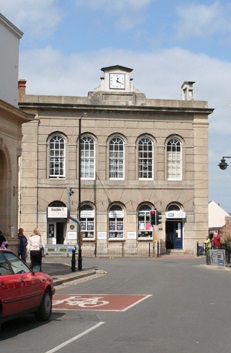Wellington Town Hall, Somerset
| Wellington Town Hall | |
|---|---|
 Wellington Town Hall | |
| Location | Fore Street, Wellington |
| Coordinates | 50°58′43″N 3°13′40″W / 50.9785°N 3.2277°W |
| Built | 1833 |
| Architectural style(s) | Neoclassical style |
Listed Building – Grade II | |
| Official name | Town Hall Offices of Wellington Weekly News |
| Designated | 25 January 1951 |
| Reference no. | 1059915 |
Wellington Town Hall is a municipal building in Fore Street, Wellington, Somerset, England. The structure, which was previously used as a civic events venue, is a Grade II listed building.[1]
History
[edit]The first municipal building in the town was a market hall which was located in the middle of the street at the junction of South Street and Fore Street and dated back to the late 17th century.[2] It contained a courtroom and a lock-up but by the early 19th century it was regarded by civic leaders as an obstruction to the highway and was demolished.[2]
In 1814, the lord of the manor, the Duke of Wellington, agreed to grant a long lease to a group of local businessmen who intended to erect a new municipal building.[3] Their objective was to provide proper accommodation for the farmers' stalls which continued to block the highway.[4] The new building was designed in the neoclassical style, built in ashlar stone and was completed in 1833.[1] The building was originally open on the ground floor, so that markets could be held, with an assembly room on the first floor. The design involved a symmetrical main frontage with five bays facing onto Fore Street; there was an arcade of five round headed sash windows on the first floor and, at roof level, there was a cornice, a parapet and a small sculpted pediment containing a clock. Internally, the principal rooms were the assembly hall, which was used for concerts and public events, and a smaller room, which was used as a library and reading room by the Wellington Literary Institute.[5] The assembly room also became the venue for county court hearings.[6]
In 1876, the lease was surrendered to the then lord of the manor, the 2nd Duke of Wellington, and, in 1884, the freehold of the property was acquired by a newly formed entity, the Wellington Market and Town Hall Company, which carried out internal improvements to the building.[7] Following a significant increase in population, largely associated with the status of Wellington as a market town, the area became an urban district in 1894.[8] Animated pictures were first shown in the town hall in 1896.[7] The council continued to use the town hall as a venue for civic events but located its council officers and their departments at council offices further southwest along Fore Street.[9] The building became the Rex Cinema in 1938 and suffered a serious fire while being used as a cinema during the 1940s.[10]
After the cinema closed in the 1950s, the condition of the building began to deteriorate and demolition was seriously considered in the 1960s.[7] Following a refurbishment the building became the offices of Wellington Weekly News,[1] but by the early 21st century it was being used as a clothes shop and as the offices of an estate agent and a firm of accountants.[11] After another refurbishment, undertaken at a cost of £2.3 million, the building re-opened as a Wetherspoons public house named as the Iron Duke, recalling the nickname for the 1st Duke of Wellington, in August 2016.[12]
References
[edit]- ^ a b c Historic England. "Town Hall Offices of Wellington Weekly News (1059915)". National Heritage List for England. Retrieved 3 October 2021.
- ^ a b Gathercole, Clare (2003). "An archaeological assessment of Wellington" (PDF). Somerset County Council. p. 13. Retrieved 2 October 2021.
- ^ "Royal Commission on Market Rights and Tolls". UK Parliament. 1889. pp. 14–24. Retrieved 2 October 2021.
- ^ Marshall, Douglas (2009). Wellington Through Time. Amberley Publishing. ISBN 978-1848685338.
- ^ Kelly's Directory of Somerset. 1883. Retrieved 3 October 2021.
- ^ Jeboult, Edward (1873). A General Account of West Somerset Description of The Valley of The Tone and the History of The Town of Taunton. Taunton: Somerset and Bristol Steam Press. p. 98.
- ^ a b c "Wellington's JD Wetherspoon: The history behind The Iron Duke". Somerset Live. 21 November 2017. Retrieved 3 October 2021.
- ^ "Wellington UD". Vision of Britain. Retrieved 3 October 2021.
- ^ "No. 45367". The London Gazette. 11 May 1971. p. 4874.
- ^ "Long History of Old Town Hall". Wellington Weekly News. 10 October 2017. Retrieved 3 October 2021.
- ^ "Town hall to public house". The Somerset County Gazette. 3 May 2002. Retrieved 3 October 2021.
- ^ "The Iron Duke, the new Wellington Wetherspoon". The Somerset County Gazette. 26 August 2016. Retrieved 3 October 2021.

